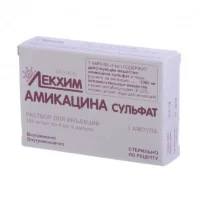Description
Abipim (Cefepime) Powder for Injections 1000 mg. №1
Composition
Active Ingredient: Cefepime. Inactive ingredients may include mannitol and sodium carbonate.
Mechanism of Action
Pharmacological Properties: Cefepime, a fourth-generation cephalosporin, exerts its antibacterial effects by inhibiting bacterial cell wall synthesis. It demonstrates enhanced activity against many resistant organisms.
Indications for Use
Indications: Abipim is indicated for the treatment of moderate to severe infections caused by susceptible bacteria.
Contraindications
Contraindications: Avoid the use of Abipim in individuals with a known allergy to cefepime or other cephalosporins.
Side Effects
Side Effects: Common side effects may include nausea, vomiting, diarrhea, and rash. While severe allergic reactions are rare, they are possible.
Usage Instructions
Dosage: The typical adult dosage is 1 to 2 grams every 12 hours. Adjustments in dosage may be necessary depending on the infection’s severity.
Administration: Abipim is designated for intravenous use only. Prior to administration, it must be reconstituted and diluted.
Benefits Compared to Analogues
Advantages: Abipim provides a wide spectrum of activity against both Gram-positive and Gram-negative bacteria, making it a valuable choice for managing various infections.
Suitable Patient Groups
Population Suitability: Abipim is appropriate for use in adults and pediatric patients. Dosage adjustments may be required for elderly individuals and those with renal impairment.
Storage and Shelf Life
Storage: Adhere to the manufacturer’s storage guidelines. Do not use the product beyond the expiration date specified on the packaging.
Packaging Description
Packaging: Abipim is supplied as a powder for injections in single-dose vials, each containing 1000 mg of cefepime.
Clinical Evidence and Proven Effectiveness
Effectiveness: Clinical trials have demonstrated the efficacy of Abipim (cefepime) in treating various bacterial infections, including pneumonia, urinary tract infections, and intra-abdominal infections.





